Tesco PLC: Innovation, Industry Overview, and SWOT Analysis Report
VerifiedAdded on 2020/12/29
|11
|2974
|403
Report
AI Summary
This report provides a comprehensive analysis of Tesco PLC's innovation strategies and performance. It begins with an executive summary and introduction, followed by an overview of Tesco's innovation history, including key milestones such as the introduction of self-service shops, the Clubcard loyalty program, and online services. The report then delves into the company's current innovation performance and capabilities, including its future plans for food delivery services, thumb recognition, and online medical shopping lists. A SWOT analysis is conducted to assess Tesco's strengths, weaknesses, opportunities, and threats. The report also includes an industry overview, discussing the retail sector and applying Porter's five forces model. Finally, PESTLE analysis is used to examine the external factors impacting Tesco's innovation. The report concludes that innovation is crucial for Tesco's growth and competitive survival, highlighting the importance of adapting to technological advancements and customer needs.

CW 1
Paraphrase This Document
Need a fresh take? Get an instant paraphrase of this document with our AI Paraphraser
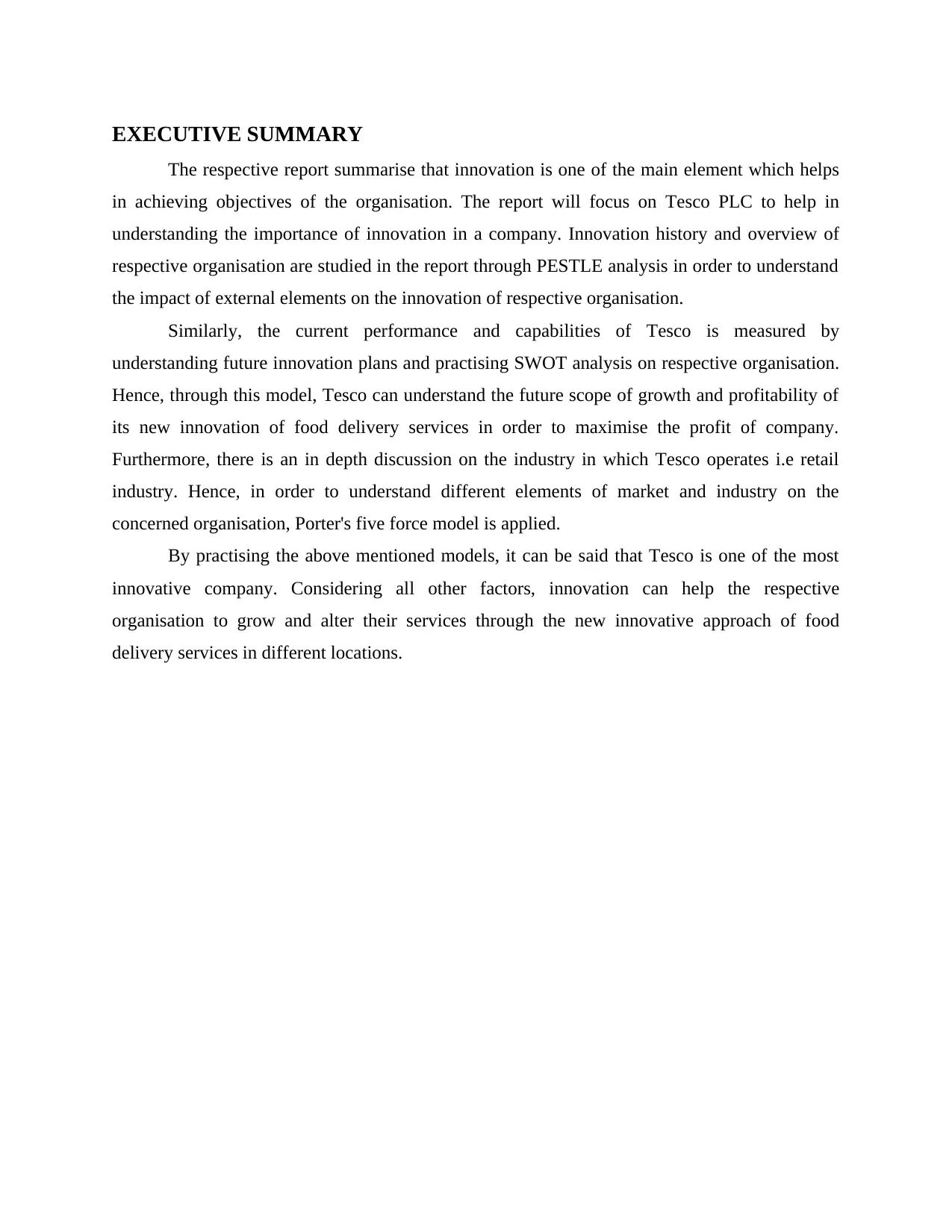
EXECUTIVE SUMMARY
The respective report summarise that innovation is one of the main element which helps
in achieving objectives of the organisation. The report will focus on Tesco PLC to help in
understanding the importance of innovation in a company. Innovation history and overview of
respective organisation are studied in the report through PESTLE analysis in order to understand
the impact of external elements on the innovation of respective organisation.
Similarly, the current performance and capabilities of Tesco is measured by
understanding future innovation plans and practising SWOT analysis on respective organisation.
Hence, through this model, Tesco can understand the future scope of growth and profitability of
its new innovation of food delivery services in order to maximise the profit of company.
Furthermore, there is an in depth discussion on the industry in which Tesco operates i.e retail
industry. Hence, in order to understand different elements of market and industry on the
concerned organisation, Porter's five force model is applied.
By practising the above mentioned models, it can be said that Tesco is one of the most
innovative company. Considering all other factors, innovation can help the respective
organisation to grow and alter their services through the new innovative approach of food
delivery services in different locations.
The respective report summarise that innovation is one of the main element which helps
in achieving objectives of the organisation. The report will focus on Tesco PLC to help in
understanding the importance of innovation in a company. Innovation history and overview of
respective organisation are studied in the report through PESTLE analysis in order to understand
the impact of external elements on the innovation of respective organisation.
Similarly, the current performance and capabilities of Tesco is measured by
understanding future innovation plans and practising SWOT analysis on respective organisation.
Hence, through this model, Tesco can understand the future scope of growth and profitability of
its new innovation of food delivery services in order to maximise the profit of company.
Furthermore, there is an in depth discussion on the industry in which Tesco operates i.e retail
industry. Hence, in order to understand different elements of market and industry on the
concerned organisation, Porter's five force model is applied.
By practising the above mentioned models, it can be said that Tesco is one of the most
innovative company. Considering all other factors, innovation can help the respective
organisation to grow and alter their services through the new innovative approach of food
delivery services in different locations.

⊘ This is a preview!⊘
Do you want full access?
Subscribe today to unlock all pages.

Trusted by 1+ million students worldwide
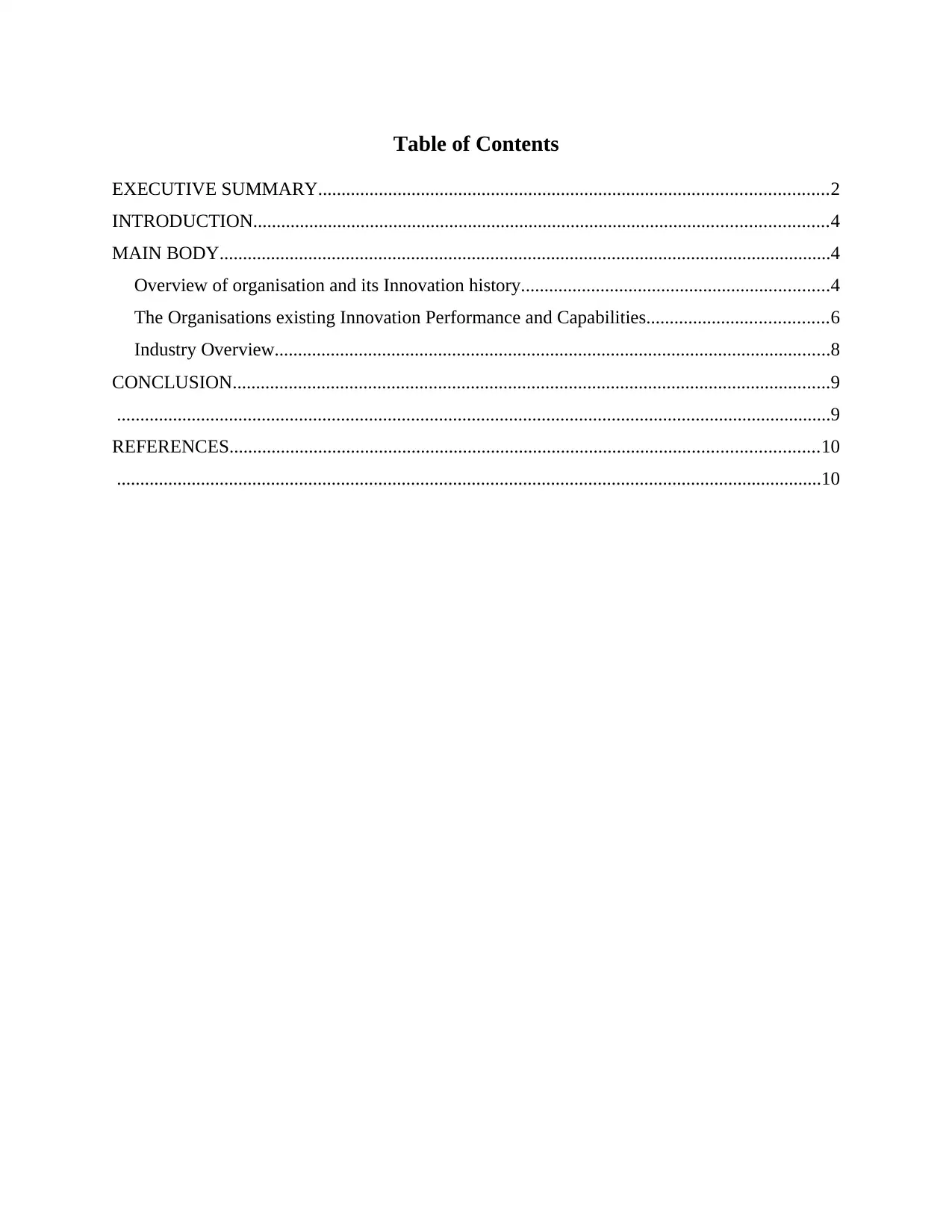
Table of Contents
EXECUTIVE SUMMARY.............................................................................................................2
INTRODUCTION...........................................................................................................................4
MAIN BODY...................................................................................................................................4
Overview of organisation and its Innovation history..................................................................4
The Organisations existing Innovation Performance and Capabilities.......................................6
Industry Overview.......................................................................................................................8
CONCLUSION................................................................................................................................9
.........................................................................................................................................................9
REFERENCES..............................................................................................................................10
.......................................................................................................................................................10
EXECUTIVE SUMMARY.............................................................................................................2
INTRODUCTION...........................................................................................................................4
MAIN BODY...................................................................................................................................4
Overview of organisation and its Innovation history..................................................................4
The Organisations existing Innovation Performance and Capabilities.......................................6
Industry Overview.......................................................................................................................8
CONCLUSION................................................................................................................................9
.........................................................................................................................................................9
REFERENCES..............................................................................................................................10
.......................................................................................................................................................10
Paraphrase This Document
Need a fresh take? Get an instant paraphrase of this document with our AI Paraphraser
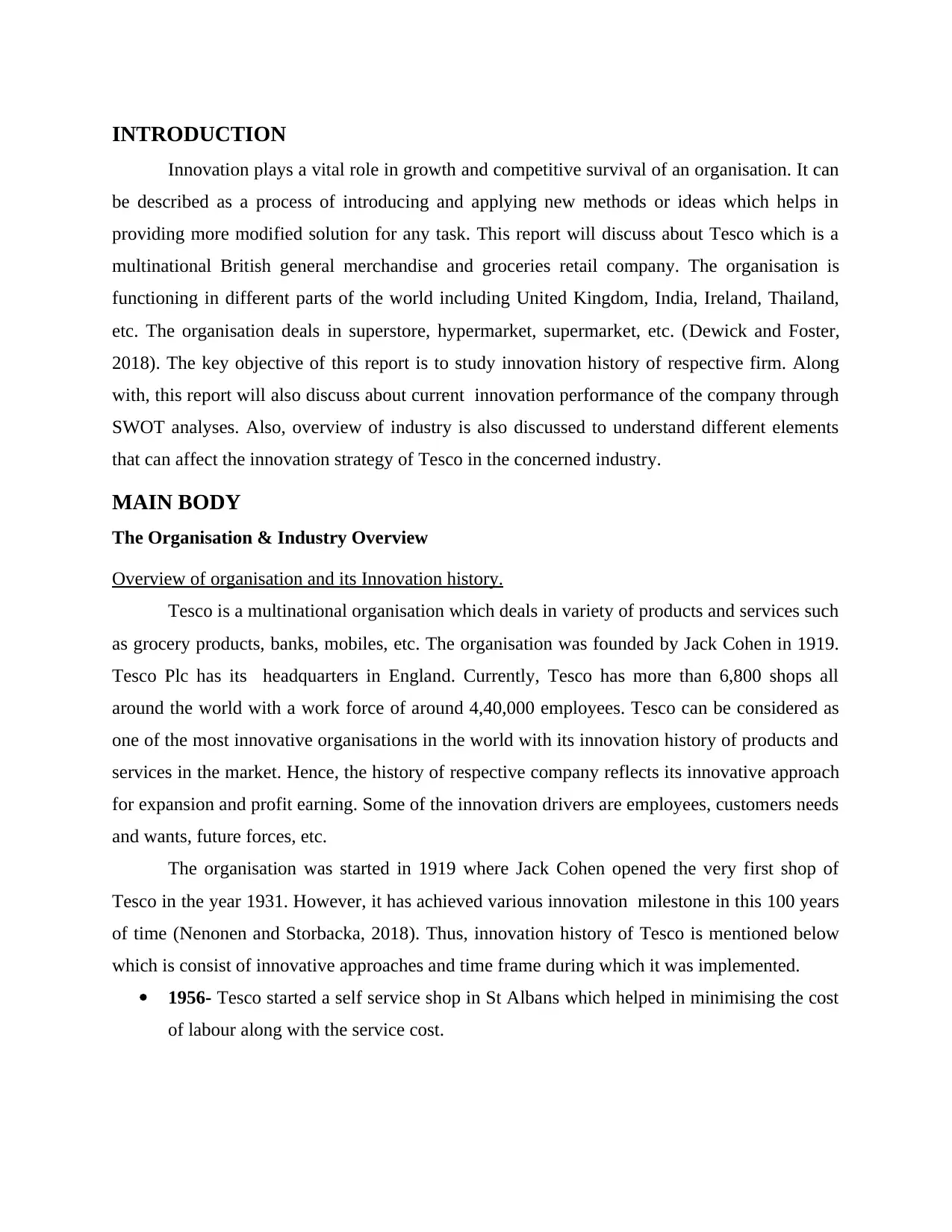
INTRODUCTION
Innovation plays a vital role in growth and competitive survival of an organisation. It can
be described as a process of introducing and applying new methods or ideas which helps in
providing more modified solution for any task. This report will discuss about Tesco which is a
multinational British general merchandise and groceries retail company. The organisation is
functioning in different parts of the world including United Kingdom, India, Ireland, Thailand,
etc. The organisation deals in superstore, hypermarket, supermarket, etc. (Dewick and Foster,
2018). The key objective of this report is to study innovation history of respective firm. Along
with, this report will also discuss about current innovation performance of the company through
SWOT analyses. Also, overview of industry is also discussed to understand different elements
that can affect the innovation strategy of Tesco in the concerned industry.
MAIN BODY
The Organisation & Industry Overview
Overview of organisation and its Innovation history.
Tesco is a multinational organisation which deals in variety of products and services such
as grocery products, banks, mobiles, etc. The organisation was founded by Jack Cohen in 1919.
Tesco Plc has its headquarters in England. Currently, Tesco has more than 6,800 shops all
around the world with a work force of around 4,40,000 employees. Tesco can be considered as
one of the most innovative organisations in the world with its innovation history of products and
services in the market. Hence, the history of respective company reflects its innovative approach
for expansion and profit earning. Some of the innovation drivers are employees, customers needs
and wants, future forces, etc.
The organisation was started in 1919 where Jack Cohen opened the very first shop of
Tesco in the year 1931. However, it has achieved various innovation milestone in this 100 years
of time (Nenonen and Storbacka, 2018). Thus, innovation history of Tesco is mentioned below
which is consist of innovative approaches and time frame during which it was implemented.
1956- Tesco started a self service shop in St Albans which helped in minimising the cost
of labour along with the service cost.
Innovation plays a vital role in growth and competitive survival of an organisation. It can
be described as a process of introducing and applying new methods or ideas which helps in
providing more modified solution for any task. This report will discuss about Tesco which is a
multinational British general merchandise and groceries retail company. The organisation is
functioning in different parts of the world including United Kingdom, India, Ireland, Thailand,
etc. The organisation deals in superstore, hypermarket, supermarket, etc. (Dewick and Foster,
2018). The key objective of this report is to study innovation history of respective firm. Along
with, this report will also discuss about current innovation performance of the company through
SWOT analyses. Also, overview of industry is also discussed to understand different elements
that can affect the innovation strategy of Tesco in the concerned industry.
MAIN BODY
The Organisation & Industry Overview
Overview of organisation and its Innovation history.
Tesco is a multinational organisation which deals in variety of products and services such
as grocery products, banks, mobiles, etc. The organisation was founded by Jack Cohen in 1919.
Tesco Plc has its headquarters in England. Currently, Tesco has more than 6,800 shops all
around the world with a work force of around 4,40,000 employees. Tesco can be considered as
one of the most innovative organisations in the world with its innovation history of products and
services in the market. Hence, the history of respective company reflects its innovative approach
for expansion and profit earning. Some of the innovation drivers are employees, customers needs
and wants, future forces, etc.
The organisation was started in 1919 where Jack Cohen opened the very first shop of
Tesco in the year 1931. However, it has achieved various innovation milestone in this 100 years
of time (Nenonen and Storbacka, 2018). Thus, innovation history of Tesco is mentioned below
which is consist of innovative approaches and time frame during which it was implemented.
1956- Tesco started a self service shop in St Albans which helped in minimising the cost
of labour along with the service cost.
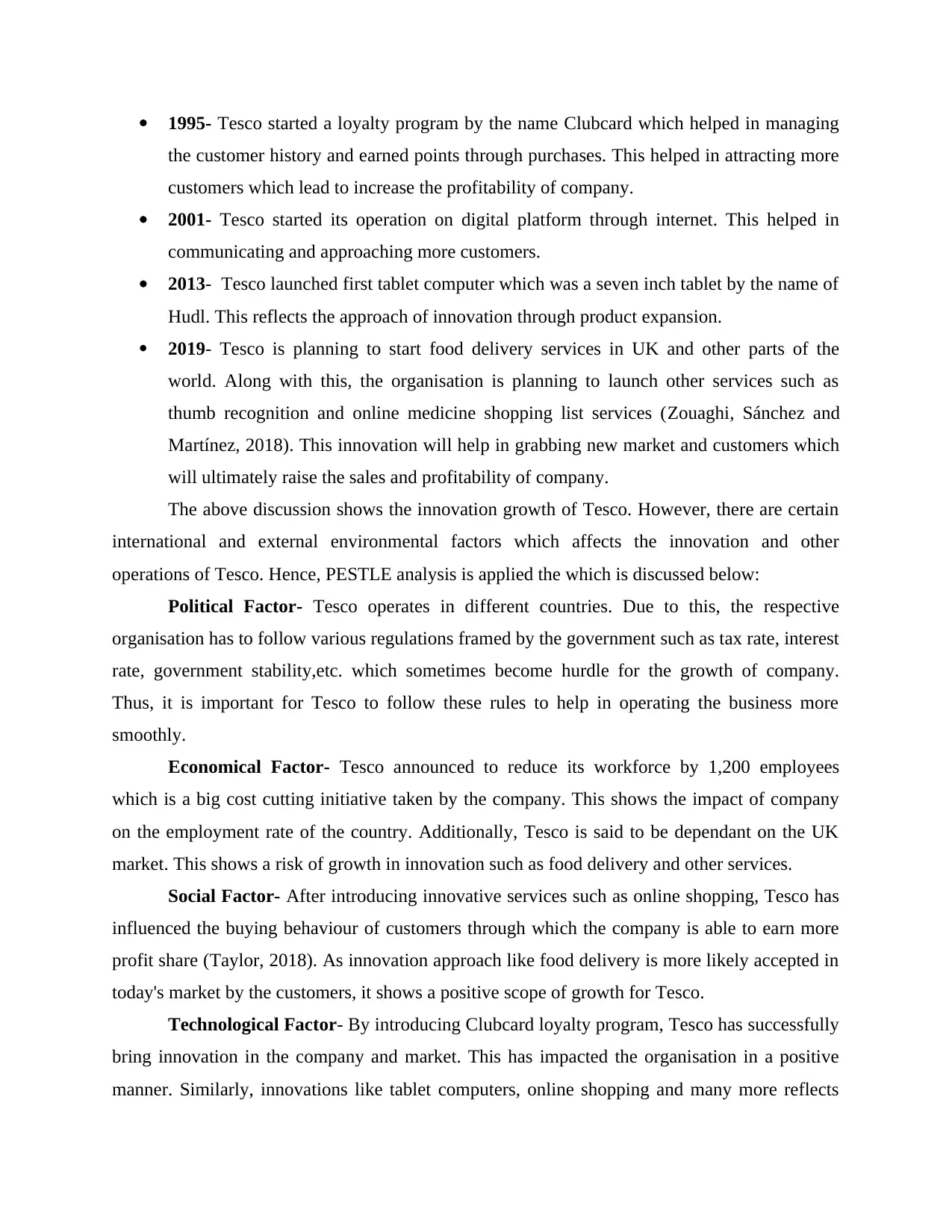
1995- Tesco started a loyalty program by the name Clubcard which helped in managing
the customer history and earned points through purchases. This helped in attracting more
customers which lead to increase the profitability of company.
2001- Tesco started its operation on digital platform through internet. This helped in
communicating and approaching more customers.
2013- Tesco launched first tablet computer which was a seven inch tablet by the name of
Hudl. This reflects the approach of innovation through product expansion.
2019- Tesco is planning to start food delivery services in UK and other parts of the
world. Along with this, the organisation is planning to launch other services such as
thumb recognition and online medicine shopping list services (Zouaghi, Sánchez and
Martínez, 2018). This innovation will help in grabbing new market and customers which
will ultimately raise the sales and profitability of company.
The above discussion shows the innovation growth of Tesco. However, there are certain
international and external environmental factors which affects the innovation and other
operations of Tesco. Hence, PESTLE analysis is applied the which is discussed below:
Political Factor- Tesco operates in different countries. Due to this, the respective
organisation has to follow various regulations framed by the government such as tax rate, interest
rate, government stability,etc. which sometimes become hurdle for the growth of company.
Thus, it is important for Tesco to follow these rules to help in operating the business more
smoothly.
Economical Factor- Tesco announced to reduce its workforce by 1,200 employees
which is a big cost cutting initiative taken by the company. This shows the impact of company
on the employment rate of the country. Additionally, Tesco is said to be dependant on the UK
market. This shows a risk of growth in innovation such as food delivery and other services.
Social Factor- After introducing innovative services such as online shopping, Tesco has
influenced the buying behaviour of customers through which the company is able to earn more
profit share (Taylor, 2018). As innovation approach like food delivery is more likely accepted in
today's market by the customers, it shows a positive scope of growth for Tesco.
Technological Factor- By introducing Clubcard loyalty program, Tesco has successfully
bring innovation in the company and market. This has impacted the organisation in a positive
manner. Similarly, innovations like tablet computers, online shopping and many more reflects
the customer history and earned points through purchases. This helped in attracting more
customers which lead to increase the profitability of company.
2001- Tesco started its operation on digital platform through internet. This helped in
communicating and approaching more customers.
2013- Tesco launched first tablet computer which was a seven inch tablet by the name of
Hudl. This reflects the approach of innovation through product expansion.
2019- Tesco is planning to start food delivery services in UK and other parts of the
world. Along with this, the organisation is planning to launch other services such as
thumb recognition and online medicine shopping list services (Zouaghi, Sánchez and
Martínez, 2018). This innovation will help in grabbing new market and customers which
will ultimately raise the sales and profitability of company.
The above discussion shows the innovation growth of Tesco. However, there are certain
international and external environmental factors which affects the innovation and other
operations of Tesco. Hence, PESTLE analysis is applied the which is discussed below:
Political Factor- Tesco operates in different countries. Due to this, the respective
organisation has to follow various regulations framed by the government such as tax rate, interest
rate, government stability,etc. which sometimes become hurdle for the growth of company.
Thus, it is important for Tesco to follow these rules to help in operating the business more
smoothly.
Economical Factor- Tesco announced to reduce its workforce by 1,200 employees
which is a big cost cutting initiative taken by the company. This shows the impact of company
on the employment rate of the country. Additionally, Tesco is said to be dependant on the UK
market. This shows a risk of growth in innovation such as food delivery and other services.
Social Factor- After introducing innovative services such as online shopping, Tesco has
influenced the buying behaviour of customers through which the company is able to earn more
profit share (Taylor, 2018). As innovation approach like food delivery is more likely accepted in
today's market by the customers, it shows a positive scope of growth for Tesco.
Technological Factor- By introducing Clubcard loyalty program, Tesco has successfully
bring innovation in the company and market. This has impacted the organisation in a positive
manner. Similarly, innovations like tablet computers, online shopping and many more reflects
⊘ This is a preview!⊘
Do you want full access?
Subscribe today to unlock all pages.

Trusted by 1+ million students worldwide
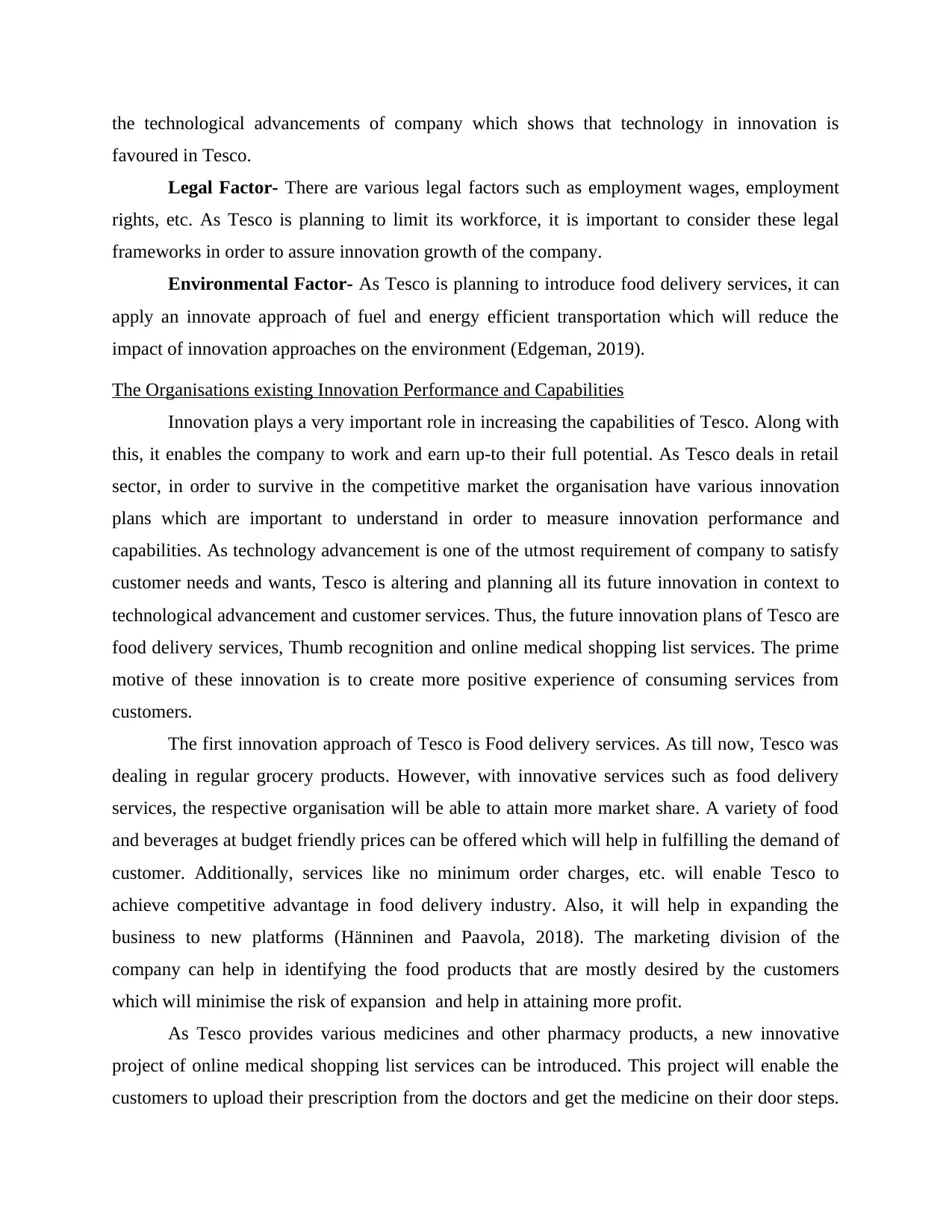
the technological advancements of company which shows that technology in innovation is
favoured in Tesco.
Legal Factor- There are various legal factors such as employment wages, employment
rights, etc. As Tesco is planning to limit its workforce, it is important to consider these legal
frameworks in order to assure innovation growth of the company.
Environmental Factor- As Tesco is planning to introduce food delivery services, it can
apply an innovate approach of fuel and energy efficient transportation which will reduce the
impact of innovation approaches on the environment (Edgeman, 2019).
The Organisations existing Innovation Performance and Capabilities
Innovation plays a very important role in increasing the capabilities of Tesco. Along with
this, it enables the company to work and earn up-to their full potential. As Tesco deals in retail
sector, in order to survive in the competitive market the organisation have various innovation
plans which are important to understand in order to measure innovation performance and
capabilities. As technology advancement is one of the utmost requirement of company to satisfy
customer needs and wants, Tesco is altering and planning all its future innovation in context to
technological advancement and customer services. Thus, the future innovation plans of Tesco are
food delivery services, Thumb recognition and online medical shopping list services. The prime
motive of these innovation is to create more positive experience of consuming services from
customers.
The first innovation approach of Tesco is Food delivery services. As till now, Tesco was
dealing in regular grocery products. However, with innovative services such as food delivery
services, the respective organisation will be able to attain more market share. A variety of food
and beverages at budget friendly prices can be offered which will help in fulfilling the demand of
customer. Additionally, services like no minimum order charges, etc. will enable Tesco to
achieve competitive advantage in food delivery industry. Also, it will help in expanding the
business to new platforms (Hänninen and Paavola, 2018). The marketing division of the
company can help in identifying the food products that are mostly desired by the customers
which will minimise the risk of expansion and help in attaining more profit.
As Tesco provides various medicines and other pharmacy products, a new innovative
project of online medical shopping list services can be introduced. This project will enable the
customers to upload their prescription from the doctors and get the medicine on their door steps.
favoured in Tesco.
Legal Factor- There are various legal factors such as employment wages, employment
rights, etc. As Tesco is planning to limit its workforce, it is important to consider these legal
frameworks in order to assure innovation growth of the company.
Environmental Factor- As Tesco is planning to introduce food delivery services, it can
apply an innovate approach of fuel and energy efficient transportation which will reduce the
impact of innovation approaches on the environment (Edgeman, 2019).
The Organisations existing Innovation Performance and Capabilities
Innovation plays a very important role in increasing the capabilities of Tesco. Along with
this, it enables the company to work and earn up-to their full potential. As Tesco deals in retail
sector, in order to survive in the competitive market the organisation have various innovation
plans which are important to understand in order to measure innovation performance and
capabilities. As technology advancement is one of the utmost requirement of company to satisfy
customer needs and wants, Tesco is altering and planning all its future innovation in context to
technological advancement and customer services. Thus, the future innovation plans of Tesco are
food delivery services, Thumb recognition and online medical shopping list services. The prime
motive of these innovation is to create more positive experience of consuming services from
customers.
The first innovation approach of Tesco is Food delivery services. As till now, Tesco was
dealing in regular grocery products. However, with innovative services such as food delivery
services, the respective organisation will be able to attain more market share. A variety of food
and beverages at budget friendly prices can be offered which will help in fulfilling the demand of
customer. Additionally, services like no minimum order charges, etc. will enable Tesco to
achieve competitive advantage in food delivery industry. Also, it will help in expanding the
business to new platforms (Hänninen and Paavola, 2018). The marketing division of the
company can help in identifying the food products that are mostly desired by the customers
which will minimise the risk of expansion and help in attaining more profit.
As Tesco provides various medicines and other pharmacy products, a new innovative
project of online medical shopping list services can be introduced. This project will enable the
customers to upload their prescription from the doctors and get the medicine on their door steps.
Paraphrase This Document
Need a fresh take? Get an instant paraphrase of this document with our AI Paraphraser
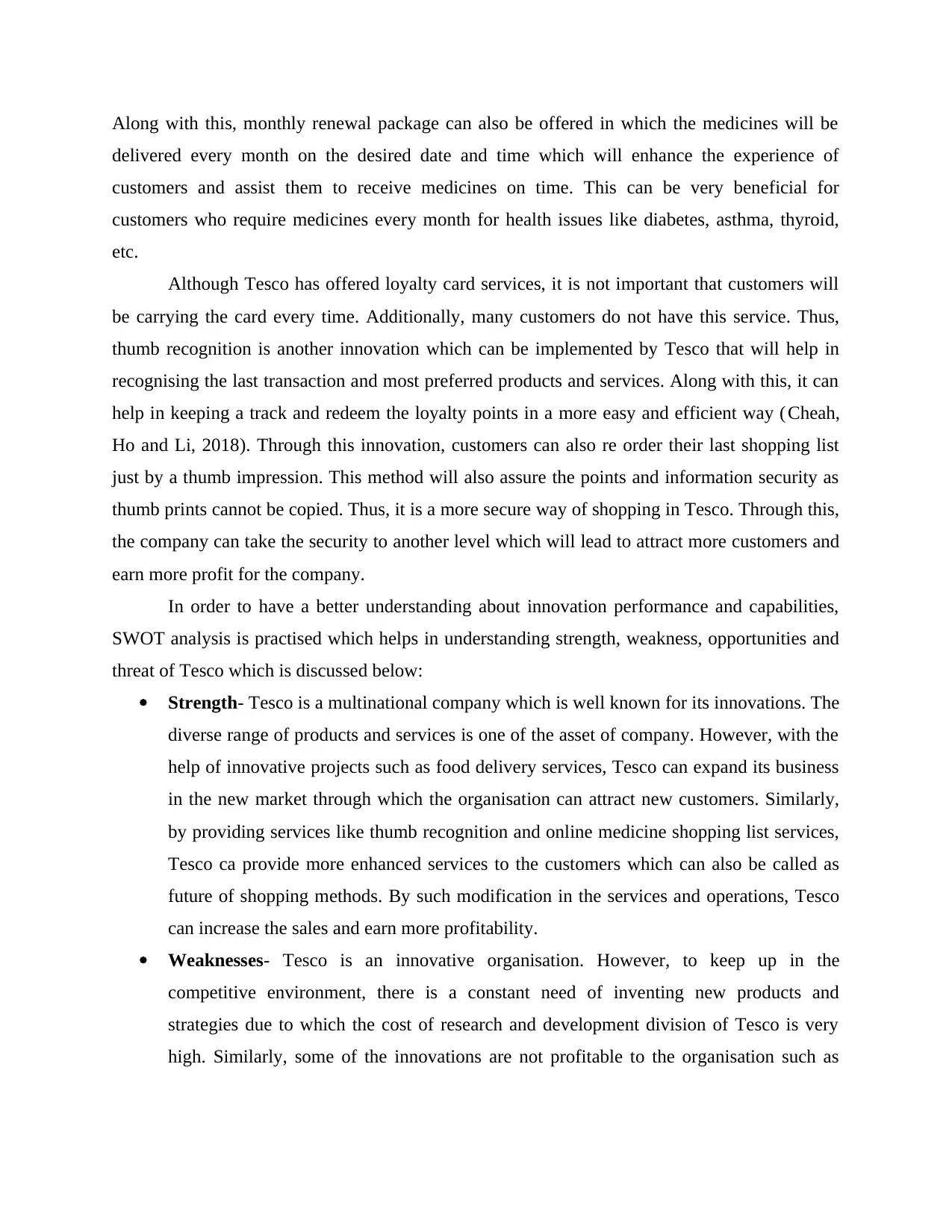
Along with this, monthly renewal package can also be offered in which the medicines will be
delivered every month on the desired date and time which will enhance the experience of
customers and assist them to receive medicines on time. This can be very beneficial for
customers who require medicines every month for health issues like diabetes, asthma, thyroid,
etc.
Although Tesco has offered loyalty card services, it is not important that customers will
be carrying the card every time. Additionally, many customers do not have this service. Thus,
thumb recognition is another innovation which can be implemented by Tesco that will help in
recognising the last transaction and most preferred products and services. Along with this, it can
help in keeping a track and redeem the loyalty points in a more easy and efficient way ( Cheah,
Ho and Li, 2018). Through this innovation, customers can also re order their last shopping list
just by a thumb impression. This method will also assure the points and information security as
thumb prints cannot be copied. Thus, it is a more secure way of shopping in Tesco. Through this,
the company can take the security to another level which will lead to attract more customers and
earn more profit for the company.
In order to have a better understanding about innovation performance and capabilities,
SWOT analysis is practised which helps in understanding strength, weakness, opportunities and
threat of Tesco which is discussed below:
Strength- Tesco is a multinational company which is well known for its innovations. The
diverse range of products and services is one of the asset of company. However, with the
help of innovative projects such as food delivery services, Tesco can expand its business
in the new market through which the organisation can attract new customers. Similarly,
by providing services like thumb recognition and online medicine shopping list services,
Tesco ca provide more enhanced services to the customers which can also be called as
future of shopping methods. By such modification in the services and operations, Tesco
can increase the sales and earn more profitability.
Weaknesses- Tesco is an innovative organisation. However, to keep up in the
competitive environment, there is a constant need of inventing new products and
strategies due to which the cost of research and development division of Tesco is very
high. Similarly, some of the innovations are not profitable to the organisation such as
delivered every month on the desired date and time which will enhance the experience of
customers and assist them to receive medicines on time. This can be very beneficial for
customers who require medicines every month for health issues like diabetes, asthma, thyroid,
etc.
Although Tesco has offered loyalty card services, it is not important that customers will
be carrying the card every time. Additionally, many customers do not have this service. Thus,
thumb recognition is another innovation which can be implemented by Tesco that will help in
recognising the last transaction and most preferred products and services. Along with this, it can
help in keeping a track and redeem the loyalty points in a more easy and efficient way ( Cheah,
Ho and Li, 2018). Through this innovation, customers can also re order their last shopping list
just by a thumb impression. This method will also assure the points and information security as
thumb prints cannot be copied. Thus, it is a more secure way of shopping in Tesco. Through this,
the company can take the security to another level which will lead to attract more customers and
earn more profit for the company.
In order to have a better understanding about innovation performance and capabilities,
SWOT analysis is practised which helps in understanding strength, weakness, opportunities and
threat of Tesco which is discussed below:
Strength- Tesco is a multinational company which is well known for its innovations. The
diverse range of products and services is one of the asset of company. However, with the
help of innovative projects such as food delivery services, Tesco can expand its business
in the new market through which the organisation can attract new customers. Similarly,
by providing services like thumb recognition and online medicine shopping list services,
Tesco ca provide more enhanced services to the customers which can also be called as
future of shopping methods. By such modification in the services and operations, Tesco
can increase the sales and earn more profitability.
Weaknesses- Tesco is an innovative organisation. However, to keep up in the
competitive environment, there is a constant need of inventing new products and
strategies due to which the cost of research and development division of Tesco is very
high. Similarly, some of the innovations are not profitable to the organisation such as
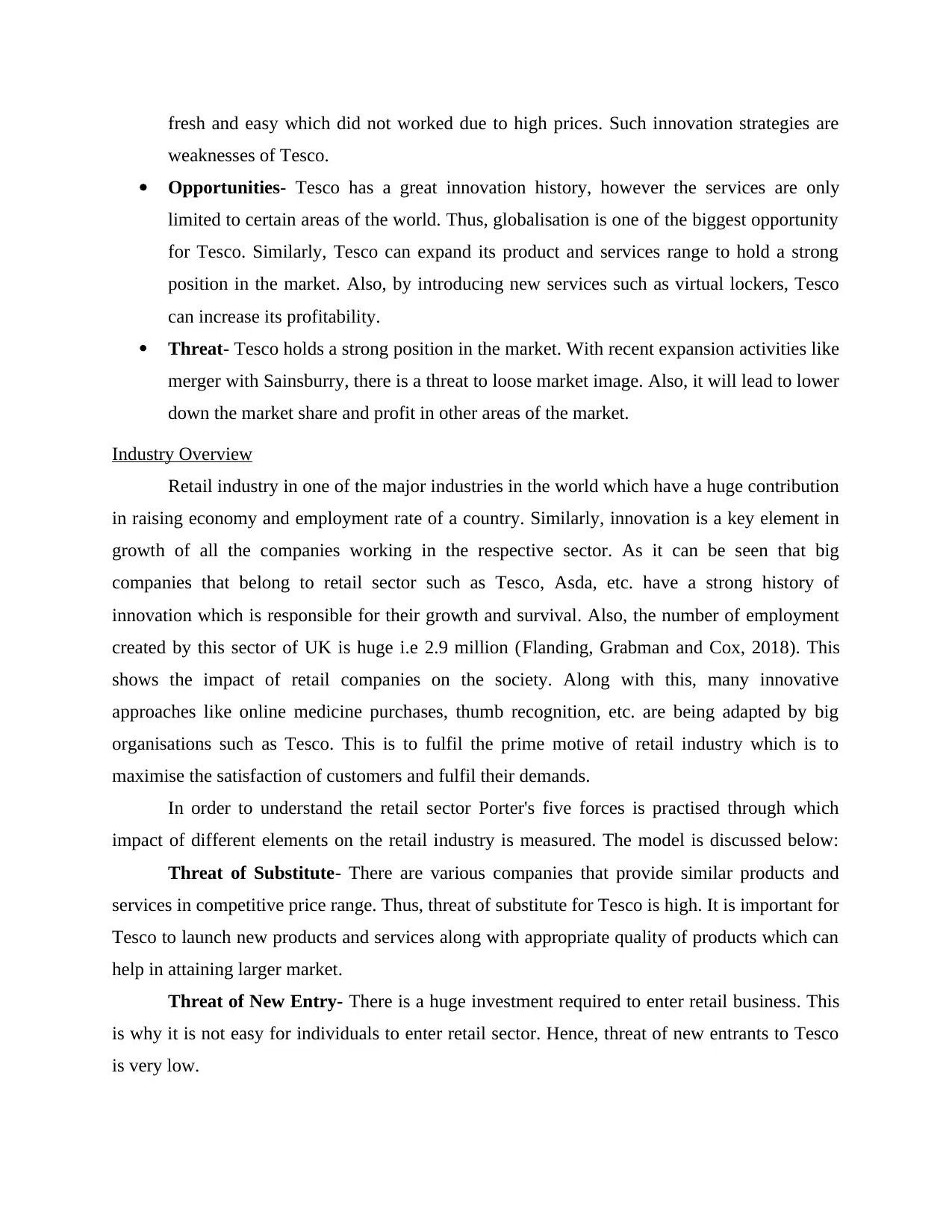
fresh and easy which did not worked due to high prices. Such innovation strategies are
weaknesses of Tesco.
Opportunities- Tesco has a great innovation history, however the services are only
limited to certain areas of the world. Thus, globalisation is one of the biggest opportunity
for Tesco. Similarly, Tesco can expand its product and services range to hold a strong
position in the market. Also, by introducing new services such as virtual lockers, Tesco
can increase its profitability.
Threat- Tesco holds a strong position in the market. With recent expansion activities like
merger with Sainsburry, there is a threat to loose market image. Also, it will lead to lower
down the market share and profit in other areas of the market.
Industry Overview
Retail industry in one of the major industries in the world which have a huge contribution
in raising economy and employment rate of a country. Similarly, innovation is a key element in
growth of all the companies working in the respective sector. As it can be seen that big
companies that belong to retail sector such as Tesco, Asda, etc. have a strong history of
innovation which is responsible for their growth and survival. Also, the number of employment
created by this sector of UK is huge i.e 2.9 million (Flanding, Grabman and Cox, 2018). This
shows the impact of retail companies on the society. Along with this, many innovative
approaches like online medicine purchases, thumb recognition, etc. are being adapted by big
organisations such as Tesco. This is to fulfil the prime motive of retail industry which is to
maximise the satisfaction of customers and fulfil their demands.
In order to understand the retail sector Porter's five forces is practised through which
impact of different elements on the retail industry is measured. The model is discussed below:
Threat of Substitute- There are various companies that provide similar products and
services in competitive price range. Thus, threat of substitute for Tesco is high. It is important for
Tesco to launch new products and services along with appropriate quality of products which can
help in attaining larger market.
Threat of New Entry- There is a huge investment required to enter retail business. This
is why it is not easy for individuals to enter retail sector. Hence, threat of new entrants to Tesco
is very low.
weaknesses of Tesco.
Opportunities- Tesco has a great innovation history, however the services are only
limited to certain areas of the world. Thus, globalisation is one of the biggest opportunity
for Tesco. Similarly, Tesco can expand its product and services range to hold a strong
position in the market. Also, by introducing new services such as virtual lockers, Tesco
can increase its profitability.
Threat- Tesco holds a strong position in the market. With recent expansion activities like
merger with Sainsburry, there is a threat to loose market image. Also, it will lead to lower
down the market share and profit in other areas of the market.
Industry Overview
Retail industry in one of the major industries in the world which have a huge contribution
in raising economy and employment rate of a country. Similarly, innovation is a key element in
growth of all the companies working in the respective sector. As it can be seen that big
companies that belong to retail sector such as Tesco, Asda, etc. have a strong history of
innovation which is responsible for their growth and survival. Also, the number of employment
created by this sector of UK is huge i.e 2.9 million (Flanding, Grabman and Cox, 2018). This
shows the impact of retail companies on the society. Along with this, many innovative
approaches like online medicine purchases, thumb recognition, etc. are being adapted by big
organisations such as Tesco. This is to fulfil the prime motive of retail industry which is to
maximise the satisfaction of customers and fulfil their demands.
In order to understand the retail sector Porter's five forces is practised through which
impact of different elements on the retail industry is measured. The model is discussed below:
Threat of Substitute- There are various companies that provide similar products and
services in competitive price range. Thus, threat of substitute for Tesco is high. It is important for
Tesco to launch new products and services along with appropriate quality of products which can
help in attaining larger market.
Threat of New Entry- There is a huge investment required to enter retail business. This
is why it is not easy for individuals to enter retail sector. Hence, threat of new entrants to Tesco
is very low.
⊘ This is a preview!⊘
Do you want full access?
Subscribe today to unlock all pages.

Trusted by 1+ million students worldwide
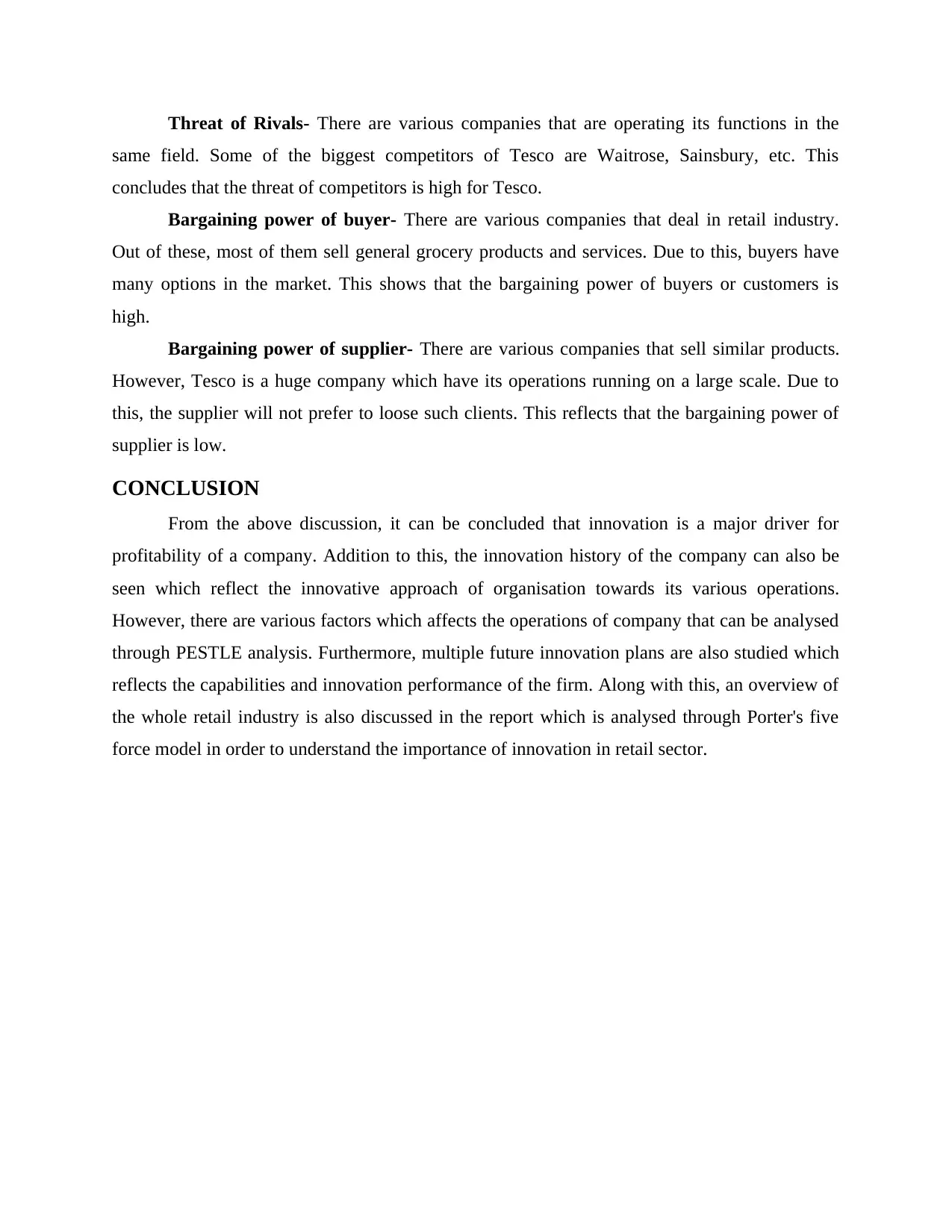
Threat of Rivals- There are various companies that are operating its functions in the
same field. Some of the biggest competitors of Tesco are Waitrose, Sainsbury, etc. This
concludes that the threat of competitors is high for Tesco.
Bargaining power of buyer- There are various companies that deal in retail industry.
Out of these, most of them sell general grocery products and services. Due to this, buyers have
many options in the market. This shows that the bargaining power of buyers or customers is
high.
Bargaining power of supplier- There are various companies that sell similar products.
However, Tesco is a huge company which have its operations running on a large scale. Due to
this, the supplier will not prefer to loose such clients. This reflects that the bargaining power of
supplier is low.
CONCLUSION
From the above discussion, it can be concluded that innovation is a major driver for
profitability of a company. Addition to this, the innovation history of the company can also be
seen which reflect the innovative approach of organisation towards its various operations.
However, there are various factors which affects the operations of company that can be analysed
through PESTLE analysis. Furthermore, multiple future innovation plans are also studied which
reflects the capabilities and innovation performance of the firm. Along with this, an overview of
the whole retail industry is also discussed in the report which is analysed through Porter's five
force model in order to understand the importance of innovation in retail sector.
same field. Some of the biggest competitors of Tesco are Waitrose, Sainsbury, etc. This
concludes that the threat of competitors is high for Tesco.
Bargaining power of buyer- There are various companies that deal in retail industry.
Out of these, most of them sell general grocery products and services. Due to this, buyers have
many options in the market. This shows that the bargaining power of buyers or customers is
high.
Bargaining power of supplier- There are various companies that sell similar products.
However, Tesco is a huge company which have its operations running on a large scale. Due to
this, the supplier will not prefer to loose such clients. This reflects that the bargaining power of
supplier is low.
CONCLUSION
From the above discussion, it can be concluded that innovation is a major driver for
profitability of a company. Addition to this, the innovation history of the company can also be
seen which reflect the innovative approach of organisation towards its various operations.
However, there are various factors which affects the operations of company that can be analysed
through PESTLE analysis. Furthermore, multiple future innovation plans are also studied which
reflects the capabilities and innovation performance of the firm. Along with this, an overview of
the whole retail industry is also discussed in the report which is analysed through Porter's five
force model in order to understand the importance of innovation in retail sector.
Paraphrase This Document
Need a fresh take? Get an instant paraphrase of this document with our AI Paraphraser
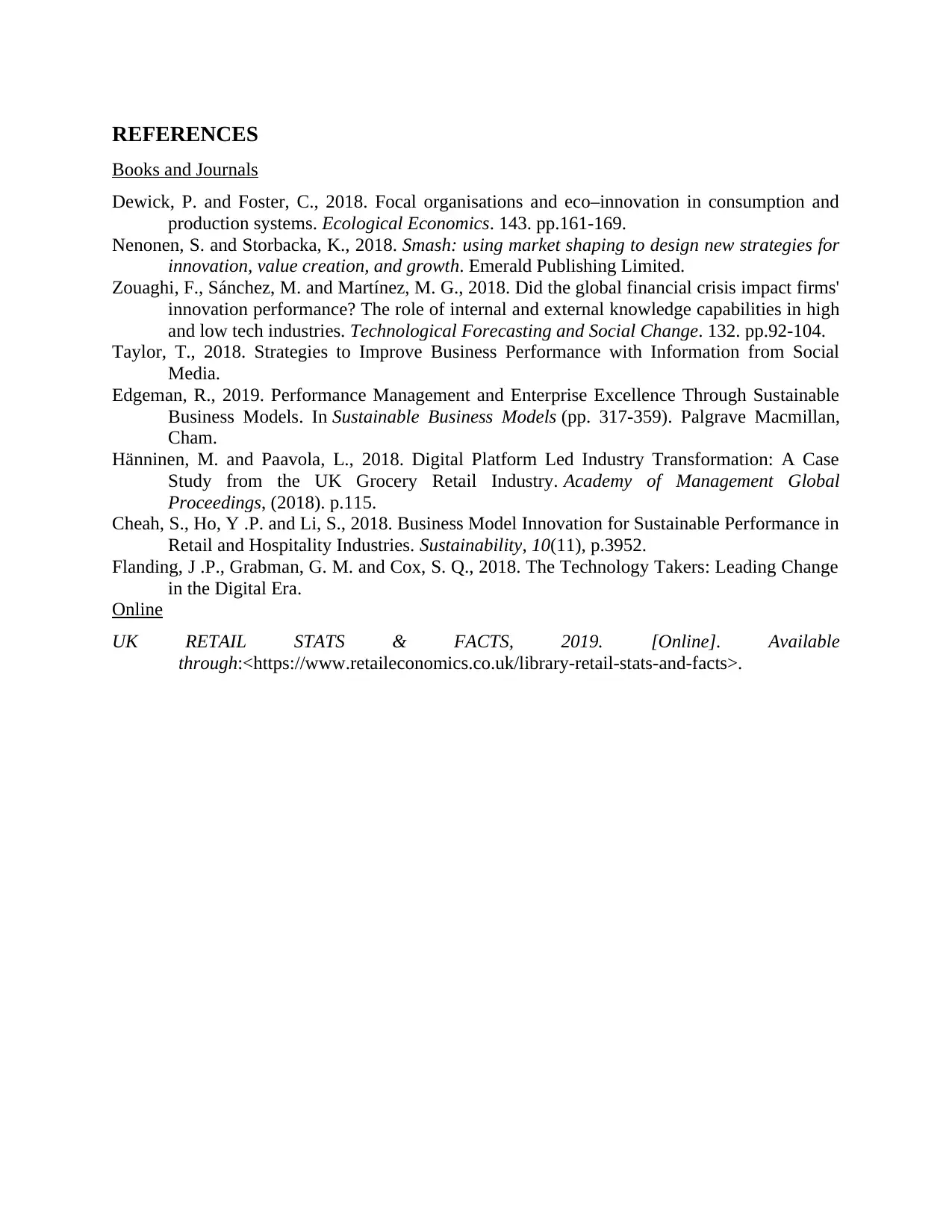
REFERENCES
Books and Journals
Dewick, P. and Foster, C., 2018. Focal organisations and eco–innovation in consumption and
production systems. Ecological Economics. 143. pp.161-169.
Nenonen, S. and Storbacka, K., 2018. Smash: using market shaping to design new strategies for
innovation, value creation, and growth. Emerald Publishing Limited.
Zouaghi, F., Sánchez, M. and Martínez, M. G., 2018. Did the global financial crisis impact firms'
innovation performance? The role of internal and external knowledge capabilities in high
and low tech industries. Technological Forecasting and Social Change. 132. pp.92-104.
Taylor, T., 2018. Strategies to Improve Business Performance with Information from Social
Media.
Edgeman, R., 2019. Performance Management and Enterprise Excellence Through Sustainable
Business Models. In Sustainable Business Models (pp. 317-359). Palgrave Macmillan,
Cham.
Hänninen, M. and Paavola, L., 2018. Digital Platform Led Industry Transformation: A Case
Study from the UK Grocery Retail Industry. Academy of Management Global
Proceedings, (2018). p.115.
Cheah, S., Ho, Y .P. and Li, S., 2018. Business Model Innovation for Sustainable Performance in
Retail and Hospitality Industries. Sustainability, 10(11), p.3952.
Flanding, J .P., Grabman, G. M. and Cox, S. Q., 2018. The Technology Takers: Leading Change
in the Digital Era.
Online
UK RETAIL STATS & FACTS, 2019. [Online]. Available
through:<https://www.retaileconomics.co.uk/library-retail-stats-and-facts>.
Books and Journals
Dewick, P. and Foster, C., 2018. Focal organisations and eco–innovation in consumption and
production systems. Ecological Economics. 143. pp.161-169.
Nenonen, S. and Storbacka, K., 2018. Smash: using market shaping to design new strategies for
innovation, value creation, and growth. Emerald Publishing Limited.
Zouaghi, F., Sánchez, M. and Martínez, M. G., 2018. Did the global financial crisis impact firms'
innovation performance? The role of internal and external knowledge capabilities in high
and low tech industries. Technological Forecasting and Social Change. 132. pp.92-104.
Taylor, T., 2018. Strategies to Improve Business Performance with Information from Social
Media.
Edgeman, R., 2019. Performance Management and Enterprise Excellence Through Sustainable
Business Models. In Sustainable Business Models (pp. 317-359). Palgrave Macmillan,
Cham.
Hänninen, M. and Paavola, L., 2018. Digital Platform Led Industry Transformation: A Case
Study from the UK Grocery Retail Industry. Academy of Management Global
Proceedings, (2018). p.115.
Cheah, S., Ho, Y .P. and Li, S., 2018. Business Model Innovation for Sustainable Performance in
Retail and Hospitality Industries. Sustainability, 10(11), p.3952.
Flanding, J .P., Grabman, G. M. and Cox, S. Q., 2018. The Technology Takers: Leading Change
in the Digital Era.
Online
UK RETAIL STATS & FACTS, 2019. [Online]. Available
through:<https://www.retaileconomics.co.uk/library-retail-stats-and-facts>.
1 out of 11
Related Documents
Your All-in-One AI-Powered Toolkit for Academic Success.
+13062052269
info@desklib.com
Available 24*7 on WhatsApp / Email
![[object Object]](/_next/static/media/star-bottom.7253800d.svg)
Unlock your academic potential
Copyright © 2020–2025 A2Z Services. All Rights Reserved. Developed and managed by ZUCOL.





